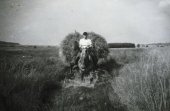Development of riverine habitats
For centuries the vegetation in the valleys of the northern Eifel was mainly the naturally occurring riverine or alluvial forest. This consisted of stands of birch, willow, alder, ash, and hornbeam. With increasing human settlement and forest clearance in the region, the birch and alder wet woodlands, and the ash and hornbeam riverine forests gradually disappeared, as was the case in the valley of the Kall. The land opened up in this way was utilized as hay meadows and grazing pasture. During this time many plants and animals that had previously existed in small forest clearings were able to expand into these extensive open spaces. These wet and poor soils meant hard work for little reward for the farmers in the Eifel. More than one hay harvest per year was not possible, since the vegetation was restricted in its growth by cold, wetness, and a lack of nutrients in the soil.
Following the arrival of technology in agriculture in the 1950s, many fields became unprofitable simply because they could not be worked by tractors. Many people abandoned the farming life altogether since there were now other possibilities of making a living. The wet alluvial lands along the Kall became economically worthless and were left fallow. Later, spruce trees were planted in many places, so that at least some income could be derived from the sale of their timber. This kind of land use meant that the native fauna and flora of riverine woodland and damp meadows had no chance of survival.
Present-day nature conservation policy in the Kall Valley has as its goal the replacement of spruce plantations by native riverine woodland, and of fallow unimproved grassland by extensively used damp meadows. In this way an original habitat type, one that results from utilization by humans, will be restored.






